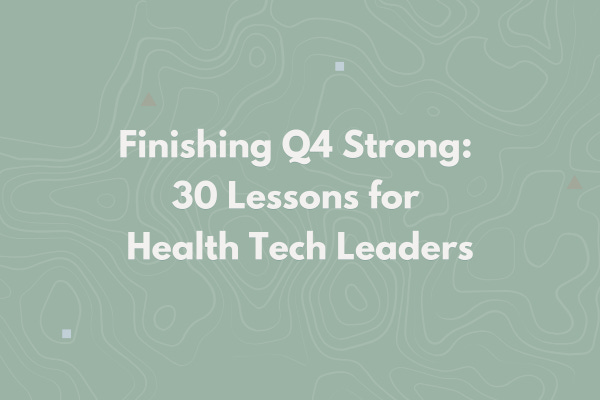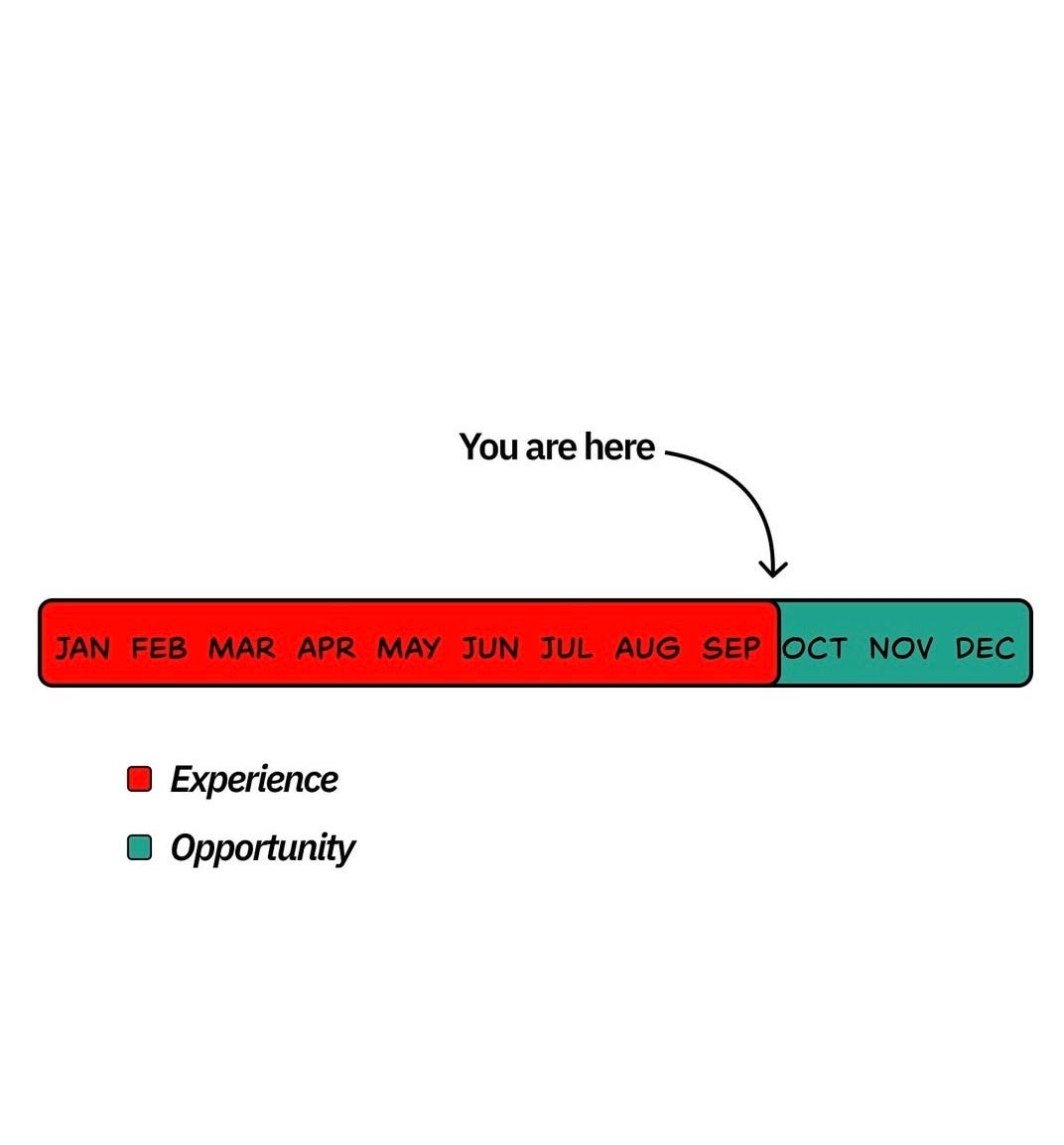Finishing Q4 Strong: 30 Lessons for Health Tech Leaders
Reminders from the trenches on what to focus on, ignore, and protect when the clock is ticking
Upward Growth provides health tech leaders with the playbooks and proof to transform complex markets into real growth. Each week, we deliver clear, practical strategies on positioning, messaging, and growth, so leaders can close enterprise deals and build repeatable momentum.
🟦 Connect with the author, Ryan Peterson, on LinkedIn.
📩 Join the CEOs, GTM leaders, and investors already reading every Tuesday.
💡 Sponsorship opportunities are available: Inquire here
I had another article lined up this week that I was excited about, but it can wait.
Because it’s Q4, and that deserves its own week of recognition.
In recent conversations, I’ve been surprised by how few companies actually sit down, as an org, to close out the year with intention. No clarity on what will be finished by Dec 31st. No reset for what starts one day later on Jan 1st.
That’s what this piece is meant to encourage.
My hope is that you’ll forward this across your org, not as a directive, but as a prompt to foster that convo of year-end prioritization. Some you send it to will agree. Some may push back. Perfect. The discussion is the point. When companies engage in real dialogue about what matters most, what no longer does, and what January will demand. They get sharper. More focused. And often better. And that’s when momentum really compounds.
This isn’t a traditional Upward Growth article. It’s a list of hard-earned lessons I’ve written down over the years: some tactical, some strategic, some oddly specific. (A few might sound like things you’d hear over a drink after a long conference day).
They’re grouped loosely by department. But they bleed together. Just like real work does.
People who’ve worked with me know I say “Finish strong” a lot. It’s something I picked up from running to describe not easing up just because the finish line’s in sight. Especially when you’re tired. And especially when you think you’ve already given enough.
However, I think “finish strong” is often misinterpreted at year-end.
It doesn’t mean forcing deals that aren’t ready.
Or shipping shaky product just to hit a roadmap line.
Or pushing execution that doesn’t serve the customer…or the company.
It does mean using Q4 to advance what will actually move the business:
Commercial momentum that creates January tailwinds
Strategic clarity about what not to keep doing
Infrastructure or headcount shifts that unlock better execution
Revenue matters. (A lot). But so does entering next year, positioned even stronger.
Here’s to finishing Q4 in a way that builds proof, not pressure.
If even one line makes you stop and say, “Yeah, we should do that,” then this list did its job.
Let’s get into it.
What I’d Tell Every Health Tech Team As Q4 Starts
1. On Executive Leadership
Q4 tests what your team actually believes and not just what’s written in the plan. These serve as reminders to stay honest and aligned:
Many executive teams confuse “update” with “insight.” If Q4 planning mostly recaps activity, it’s a postmortem, not a plan.
Every exec should be able to name: 1) what worked, 2) what’s repeatable, and 3) what we’re leaving behind. If not, go fix it before planning.
Alignment isn’t when people agree in meetings. It’s when they run the same playbook when no one’s watching.
I’ve seen companies hit their number and still lose board trust because no one could say what they’d do next with that momentum.
A strong finish doesn’t mean a strong setup. I’ve learned to check the cost of every win.
It matters less what slogan you hang on next year. It matters more whether your team actually runs their decisions through it.
2. On Marketing
Q4 isn’t the time for brand building. These reminders help Marketing support deals, not just impressions:
7. If Sales is rewriting your slides, don’t get offended. Get curious. They’re telling you what the market actually hears.
8. Strip every asset back to what helped you win. Every case study, landing page, tagline. If it didn’t close business, cut it or rewrite it until it could.
9. You don’t need to start a blog or a podcast. You need three stories that your next buyer will recognize themselves in.
10. Every case study should answer: why this buyer, why this moment, why this solution. If not, it’s just a customer spotlight.
11. Marketing should narrow the funnel, not widen it. Good positioning helps the wrong prospects disqualify themselves.
Benjamin Franklin nailed it: “Either write something worth reading or do something worth writing about.” The best companies do both.
3. On GTM & Sales
Buyers are tired, budgets are tight, and priorities are shifting. These reminders help you stay sharp and close what’s real:
Your buyers are human. Some of them just lost their bonus. Some are behind on their OKRs. Your Q4 sales strategy should show empathy, not just urgency.
Start every pipeline review this week by asking: “What has to be true for this to close in Q4?” Not “what’s next.”
The most dangerous rep in Q4 isn’t the underperformer. It’s the one with a pipeline full of “maybes” no one’s challenged.
When plans say “come back next year,” they’re not asking for a calendar reminder. They’re asking for a stronger reason to care.
Stop offering discounts that don’t create leverage. “End-of-year pricing” doesn’t motivate buyers who’ve already made peace with Q1… but they’ll still expect that EOY pricing come January.
There’s no shame in losing a deal. There’s a lot of shame in not knowing why.
“Q4 doesn’t care about your intentions. It exposes your systems, your focus, and your leadership.”
4. On Product
Q4 exposes gaps between what Product is building and what Sales needs. These lessons help close that gap fast:
A competitor being “bad” doesn’t make you good. Buyers care about what works for them, not your roadmap’s purity.
Every time you build a feature for one client, you mortgage attention from the rest. It doesn’t mean you shouldn’t, but be aware of what you’re trading.
Product teams fall in love with mechanics. Buyers fall in love with outcomes. Every release note should speak to the latter.
Before you ship one more thing this quarter, check: will this help Sales close a deal that’s already in flight? Or just look good in the roadmap?
Every new buyer in Q4 is picturing onboarding in the new year. Show them what the first 14 days will look like, not just the roadmap.
Fancy product vision decks don’t help in Q4. What Sales needs is a screenshot of exactly what the buyer gets now, not someday.
5. On Being a Team
Q4 stretches people thin. These are reminders to stay connected, step up for each other, and not lose perspective of the bigger picture:
“Let me know if you need anything” isn’t leadership. Step in. Offer something specific. Show you’re paying attention.
If something this week made you feel proud, curious, or hopeful, don’t keep it to yourself. Those are powerful fuel for the team.
Don’t leave teammates on read. Nothing erodes trust faster than silence when a team feels stretched.
Put names to every project in motion. If no one owns it, it’s already slipping.
The 3pm coffee walk is underrated. Remote or in-office, take a 15-minute stroll. Your brain (and teammates) will thank you.
Default to assuming good intent. Especially when speed or stress makes communication messier.
Bonus Tip:Always pack a spare USB cord. You never know when it’ll save a demo or spark a conversation with your next buyer.
Final Thought
If I’ve learned anything in Q4, it’s this: your business will tell you what it is.
Not what you hoped it would be. What it actually is.
And it’ll show you how you operate under pressure:
What gets your focus. What gets delayed.
What you question. What you defend.
What you choose when no next steps are obvious.
That’s why I wrote this. Not as a checklist, but as a mirror to hold up during the one quarter when everything feels just about to split at the seams.
Industries shift. Competitors get acquired. You pivot. You change roles.
But how you think under pressure is what you can control.
It’s what your team remembers. What gets repeated. What gets modeled.
And it’s what compounds.
So if even one line in here stuck with you, write it down. Argue with it. Pass it around.
Use it in a journal, a 1:1, (or a barstool debrief).
That’s how we sharpen.
Not by getting it all right. But by noticing what matters, when it matters most.
Best of luck to you in Q4. Finish strong.
The free newsletter covers the big ideas. Paid subscribers get the full breakdowns, including client-tested strategy, behind-the-scenes examples, and deeper thinking you won’t find anywhere else.
→ [Become a Paid Subscriber]
About the Author
Ryan Peterson writes Upward Growth, where he shares practical insights on selling health tech into the payor market. With 15+ years in healthcare growth leadership, he focuses on helping vendors translate their value into traction with health plans.
🟦 Connect with him on LinkedIn.



